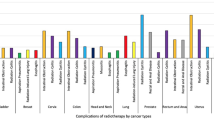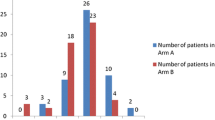Abstract
Purpose
To better understand the indirect effects of standard courses of radiation therapy (RT) on distant tissue toxicity, we evaluated the frequency, course, and health and economic burden of regimen-related diarrhea in a large, multinational group of patients who were being treated for cancers of the head and neck (HNC) or lung (NSCLC).
Methods
In this exploratory, prospective study, 284 patients being treated for HNC and 60 being treated for NSCLC were stratified into four cohorts to evaluate the effect of radiation alone and radiation plus concomitant chemotherapy (CRT) on radiation-induced diarrhea (RID). RID was assessed daily throughout RT using a patient-reported five-point categorical scale. Health and resource use outcomes were evaluated at least weekly during radiation.
Results
Moderate to severe RID was reported in all groups and was worse among patient being treated with concomitant chemoradiation (CRT). Whereas 29 % of patients treated with radiation only developed RID, the incidence was 42 % among CRT-treated patients. Tumor site did not impact the rate of RID, but did impact the rate of development and was more acute in patients being treated for NSCLC than for HNC. Patients with significant RID had worse health and resource use outcomes than did patients without RID regardless of the form of treatment. G-tube placement, weight loss, unplanned office visits, and in-patient days were adversely affected by RID. Not surprisingly, patients treated with CRT had poorer health and resource outcomes than RT only patients, even in the absence of RID.
Conclusion
In addition to local tissue toxicities, our results suggest that focal radiation may also be associated with significant distant tissue-centric injury here represented by RID. While these changes were seen with radiation alone, the addition of chemotherapy increased the incidence and burden of illness. RID adversely impacted resource use. This unanticipated finding supports the hypothesis that focal radiation therapy results in pathobiological changes that extend beyond the radiation field and which can produce distant changes.

Similar content being viewed by others
References
Mole R (1953) Whole body irradiation—radiobiology or medicine? Br J Radiol 26:234–241
Siva S, MacManus MP, Martin RF et al (2013) Abscopal effects of radiation therapy: a clinical review for the radiobiologist. Cancer Lett (in press)
Sheung P, Lin S, Chang N et al (2009) Toxicity risk of non-target organs at risk receiving low-dose radiation: case report. Radiat Oncol 4:71–76
Gupta SC, Kim JH, Kannapan R et al (2011) Role of nuclear factor κB-mediated inflammatory pathways in cancer-related symptoms and their regulation by nutritional agents. Exp Biol Med 236:658–671
Sultani M, Stringer AM, Bowen JM et al (2013) Anti-inflammatory cytokines: important immunoregulatory factors contributing to chemotherapy-induced gastrointestinal mucositis. Chemother Res Pract. doi:10.1155/2012/490804
Sonis ST (2004) The pathobiology of mucositis. Nat Rev Cancer 4:277–284
Lin CC, Liu CY, Chen MJ et al (2013) Profiles of circulating endothelial cells and serum cytokines during adjuvant chemoradiation in rectal cancer patients. Clin Transl Oncol 15(10):855–860. doi: 10.1007/s12094-013-1004-6
Cirillo M, Venturini M, Ciccarelli L et al (2009) Clinician versus nurse symptom reporting using the National Cancer Institute-Common Terminology Criteria for Adverse Events during chemotherapy: results of a comparison based on patient’s self-reported questionnaire. Ann Oncol 20:1929–1935
Brandwein-Gensler M, Smith RV (2010) Prognostic indicators in head and neck oncology including the new 7th edition of the AJCC staging system. Head Neck Pathol 4:53–61
Elting LS, Keefe DM, Sonis ST et al (2008) Patient-reported measurements of oral mucositis in head and neck cancer patients treated with radiotherapy with or without chemotherapy. Cancer 113:2704–2713
Brizel DM, Albers ME, Fisher SR et al (1998) Hyperfractionated irradiation with or without concurrent chemotherapy for locally advanced head and neck cancer. N Engl J Med 338:1798–1804
Espeli V, Zucca E, Ghielmini M et al (2012) Weekly and 3-weekly cisplatin concurrent with intensity-modulated radiotherapy in locally advanced head and neck squamous cell cancer. Oral Oncol 48:266–271
Lau H, Brar S, Hao D et al (2006) Concomitant low-dose cisplatin and three-dimensional conformal radiotherapy for locally advanced squamous cell carcinoma of the head and neck: analysis of survival and toxicity. Head Neck 28:189–196
Bartelink H, Van den Bogaert W et al (2002) Concomitant cisplatin and radiotherapy in a conventional and modified fractionation schedule in locally advanced head and neck cancer: a randomized phase II EORTC trial. Eur J Cancer 38:667–673
Huguenin P, Beer KT, Allal A et al (2004) Concomitant cisplatin significantly improves locoregional control in advanced head and neck cancers treated with hyperfractionated radiotherapy. J Clin Oncol 22:4665–4673
Kaya AO, Buyukberber S, Benekli M et al (2010) Concomitant chemoradiotherapy with cisplatin and docetaxel followed by surgery and consolidation chemotherapy in patients with unresectable locally advanced non-small cell lung cancer. Med Oncol 27:152–157
Sanguinetti G, Sormani M, Marur S et al (2012) Effect of radiotherapy and chemotherapy on the risk of mucositis during intensity-modulated radiation therapy for oropharyngeal cancer. Int J Radiat Oncol Biol Phys 83:235–242
Baskin WN (2006) Acute complications associated with bedside placement of feeding tubes. Nutr Clin Pract 21:40–55
Acknowledgments
This study was supported by an unrestricted grant from Helsinn, Inc.
Conflict of interest
The authors declare no conflict of interest. We have full control of all primary data and agree to allow the Journal for review the data if requested.
Author information
Authors and Affiliations
Consortia
Corresponding author
Additional information
Steven Grunberg passed away during the preparation of this study.
Rights and permissions
About this article
Cite this article
Sonis, S., Elting, L., Keefe, D. et al. Unanticipated frequency and consequences of regimen-related diarrhea in patients being treated with radiation or chemoradiation regimens for cancers of the head and neck or lung. Support Care Cancer 23, 433–439 (2015). https://doi.org/10.1007/s00520-014-2395-9
Received:
Accepted:
Published:
Issue Date:
DOI: https://doi.org/10.1007/s00520-014-2395-9




